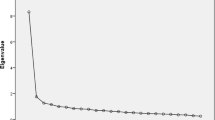Abstract
Research based on Higgin's self-discrepancytheory has generally found that depression and anxietycan be differentiated on the basis of discrepanciesbetween actual views of one's self versus one's ideal self and between actual self versus the selfothers expect. This study sought to replicate and extendthis work by comparing the self discrepancies ofindividuals with social phobia, dysthymia, and comorbid social phobia and depression with those ofmatched normal persons. Persons with generalized socialphobia or dysthymia and the comorbid group reportedgreater actual: ought/other discrepancies than did normal participants. The comorbid group, butnot the dysthymic group as expected, had elevatedactual: ideal discrepancies. Overall self-discrepancyscores were less extreme and more variable thanexpected. Implications for self-discrepancy theory andunderstanding the relation between anxiety anddepression are discussed.
Similar content being viewed by others
REFERENCES
American Psychiatric Association (1987). Diagnostic and statistical manual of mental disorders (3rd ed, revised). tWashington, DC: Author.
American Psychiatric Association (1994). Diagnostic and statistical manual of mental disorders (4th ed,). Washington, DC: Author.
Amir, N., McNally, R. J., Riemann, B. C., Burns, J. A., Lorenz, M., & Mullen, J. T. (1996). Suppression of the emotional Stroop effect by increased anxiety in patients with social phobia. Behaviour Research and Therapy, 34, 945-948.
Beck, A. T., Ward, C. H., Mendelson, M., Mock, J., & Erbaugh, J. (1961). An inventory for measuring depression. Archives of General Psychiatry, 4, 561-571.
Clark, D. A., & Steer, R. A. (1996). Empirical status of the cognitive model of anxiety and depression. In P. M. Salkovskis (Ed.), Frontier of cognitive therapy, (pp. 75-96). New York: Guilford Press.
Clark, L. A., & Watson, D. (1991). Tripartite model of anxiety and depression: Psychometric evidence and taxonomic implications. Journal of Abnormal Psychology, 100, 316-336.
Czaja, S. J. (1975). Age differences in life satisfaction as a function of discrepancy between real and ideal self concepts. Experimental Aging Research, 1, 81-89.
DiNardo, P. A., & Barlow, D. H. (1988). Anxiety Disorders Interview Schedule-Revised (ADIS-R). Albany: Center for Stress and Anxiety Disorders, University at Albany, State University of New York.
Dobson, K. S. (1985). The relationship between anxiety and depression. Clinical Psychology Review, 5, 307-324.
Heimberg, R. G., Holt, C. S., Schneie r, F. R., Spitzer, R. L., & Liebowitz, M. R. (1987). The issue of subtypes in the diagnosis of social phobia. Journal of Anxiety Disorder, 7, 249-269.
Higgins, E. T. (1987). Self-discrepancy: A theory relating self and affect. Psychological Review, 94, 319-340.
Higgins, E. T. (1989). Self-discrepancy theory: What patterns of self-beliefs cause people to suffer? Advances in Experimental Social Psychology, 22, 93-136.
Higgins, E. T., Bond, R., Klein, R., & Strauman, T. J. (1986). Self-discrepancies and emotional vulnerability: How magnitude, accessibility and type of discrepancy influence affect. Journal of Personality and Social Psychology, 41, 1-15.
Higgins, E. T., Klein, R., & Strauman, T. (1985). Self-concept discrepancy theory: A psychological model for distinguishing among different aspects of depression and anxiety. Social Cognition, 3, 51-76.
Hope, D. A., Herbert, J. D., & White, C. (1995). Diagnostic subtype, avoidant personality disorder, and efficacy of cognitive behavioral group therapy for social phobia. Cognitive Therapy and Research, 19, 285-303.
Ingram, R. (1989). Affective confounds in social-cognitive research. Journal of Personality and Social Psychology, 57, 715-722.
Kipfer, B. A. (Ed.). (1992). Roget's 21st Century Thesaurus. New York: Dell.
Loranger, A. W. (1988). Personality Disorders Examination manual. Yonkers, NY: D. V. Communications.
Lydiard, R. B. (1991). Coexisting depression and anxiety: Special diagnostic and treatment issues. Journal of Clinical Psychiatry, 52, 48-54.
McNeil, D. W., Ries, B. J., Taylor, L. J., Boone, M. L., Carter, L. E., Turk, C. L., & Lewin, M. R. (1995). Comparison of social phobia subtypes using Stroop tests. Journal of Anxiety Disorders, 9, 47-57.
Oliver, J. M., Ross, M. J., Maier, M., & Wiener, R. L. (1991). Cognitive vulnerability to depression as revealed by vulnerability markers. Journal of Social Behavior and Personality, 6, 585-596.
Persons, J. B. (1986). The advantages of studying psychological phenomena rather than psychiatric diagnoses. American Psychologist, 41, 1252-1260.
Preskhorn, S. H., & Fast, G. A. (1993). Beyond signs and symptoms: The case against a mixed anxiety and depression category. Journal of Clinical Psychiatry, 54, 24-32.
Riemann, B. C., & McNally, R. J. (1995). Cognitive processing of personally relevant information. Cognition and Emotion, 9, 325-340.
Scott, L., & O'Hara, M. W. (1993). Self-discrepancies in clinically anxious and depressed university students. Journal of Abnormal Psychology, 102, 282-287.
Segal, Z. V. (1988). Appraisal of self-schema construct in cognitive models of depression. Psychological Bulletin, 103, 147-167.
Spitzer, R. L., Williams, J. B., Gibbon, M., & First, M. B., (1989). Structured Clinical Interview for DSM-III-R, (9/1/89 revision). New York: New York Biometric Institute, Research Department, New York State Psychiatric Institute.
Strauman, T. J. (1989). Self-discrepancies in clinical depression and social phobia: Cognitive structures that underlie emotional disorders? Journal of Abnormal Psychology, 98, 14-22.
Strauman, T. J. (1990). Self-guides and emotionally significant childhood memories. A study of retrieval efficiency and incidental negative emotional content. Journal of Personality and Social Psychology, 59, 869-880.
Strauman, T. J. (1992). Self-guides, autobiographical memory, and anxiety and dysphoria: Toward a cognitive model of vulnerability to emotional distress. Journal of Abnormal Psychology, 101, 87-95.
Strauman, T. J., & Higgins, E. T. (1987). Automatic activation of self-discrepancies and emotional syndromes: When cognitive structures influence affect. Journal of Personality and Social Psychology, 53, 1004-1014.
Strauman, T. J., & Higgins, E. T. (1988). Self-discrepancies as predictors of vulnerability to distinct syndromes of chronic emotional distress. Journal of Personality, 56, 685-707.
Watson, D. & Friend, R. (1969). Measurement of social-evaluative anxiety. Journal of Consulting and Clinical Psychology, 3, 448-457.
Rights and permissions
About this article
Cite this article
Weilage, M., Hope, D.A. Self-Discrepancy in Social Phobia and Dysthymia. Cognitive Therapy and Research 23, 637–650 (1999). https://doi.org/10.1023/A:1018788925223
Issue Date:
DOI: https://doi.org/10.1023/A:1018788925223




